$29900 Xiaomi Electric Car SU7 Specs, Prices, & Beyond!
Xiaomi is getting into making electric cars, and their first electric car is called the Xiaomi SU7. It’s a big deal because it’s not just any electric car—it’s a high-tech sedan designed to be powerful, eco-friendly, and smart.
Read Apple Electric Car Project: Apple Titan Electric Car
Xiaomi’s CEO, Lei Jun, compared this move to climbing a mountain, saying it’s a big step forward for the company. He believes that moving into cars is a natural progression from making smartphones.
Xiaomi wants to make top-notch cars, so they’re investing a lot of money and time into developing new technology. They’re aiming to be one of the top five carmakers globally within the next 15 to 20 years.
Read Rimac Nevera: The World’s Fastest Electric Car
Changing the Way Cars Are Made
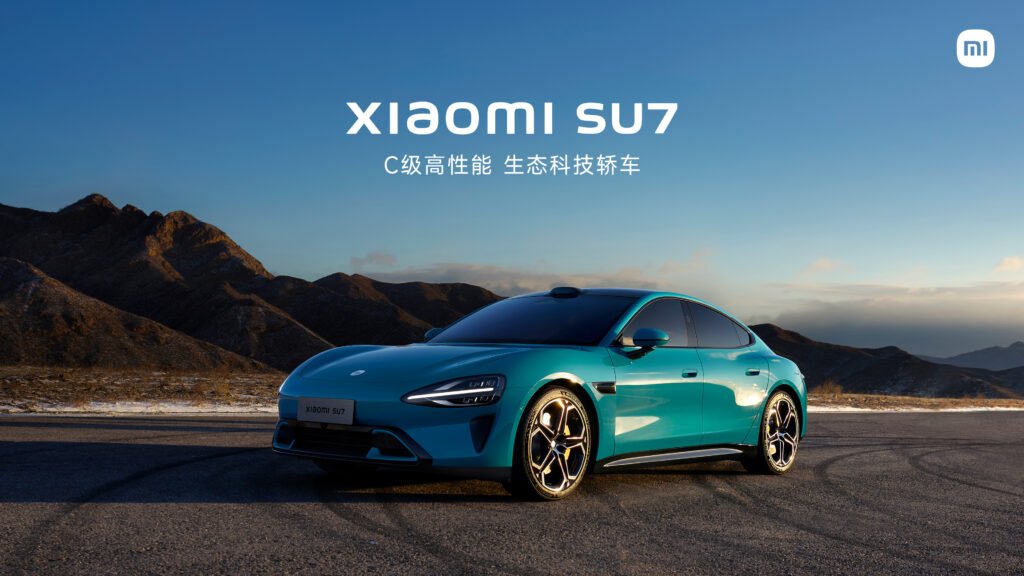
Electric cars are getting smarter, blending with gadgets and smart systems. To keep up, the automotive industry needs to fuse different technologies.
Lei Jun says Xiaomi’s electric vehicles (EVs) will shake things up by combining manufacturing, smart software, and AI. This means big changes in how cars are made.
Xiaomi EV is taking a thorough approach, starting from scratch with core technologies and deep research. They’re serious about making a great car, investing over 10 billion CNY in research and development.
With a team of over 3,400 engineers worldwide, they’re making breakthroughs in key areas like E-Motors, Batteries, Xiaomi Hyper Die-Casting, Xiaomi Pilot Autonomous Driving, and Smart Cabin. These innovations show Xiaomi’s impressive 13-year journey in technology.
Read Alef Flying Car: Alef Aeronautics Model A
Xiaomi Electric Car SU7 E-Motors
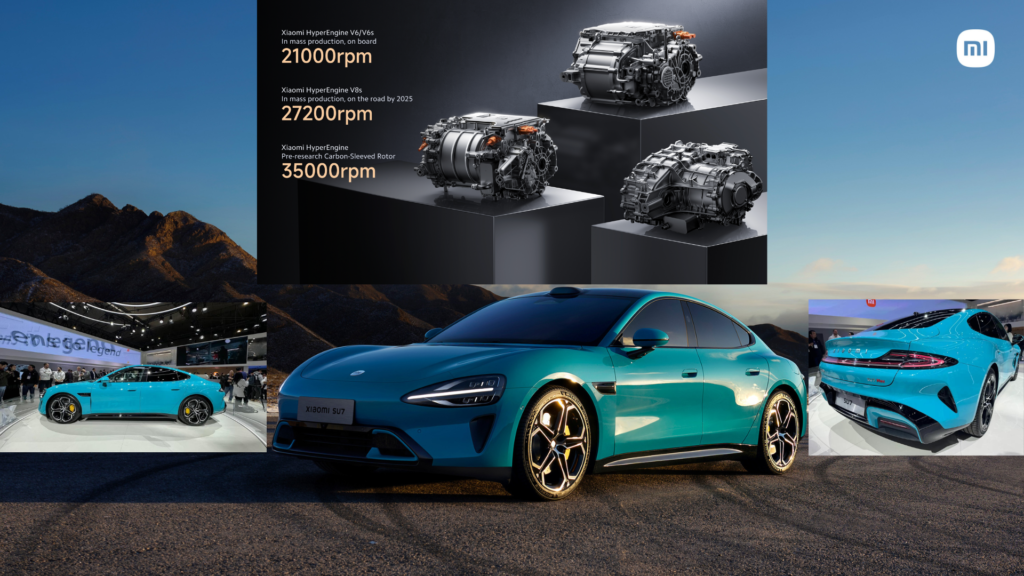
Xiaomi unveiled its electric motors at the conference—the HyperEngine V6/V6s and HyperEngine V8s. These motors use cool tech like Bidirectional Full Oil Cooling and special oil circuit designs.
They’re so good that they can match the performance of old-school V8 and V6 engines but without the gas-guzzling. The HyperEngine V8s is a standout, breaking records with its super-fast speed of 27,200 rpm and powerful output.
It’s made with ultra-strong materials, like silicon steel plates with a tensile strength of 960MPa. This makes it twice as tough as other motors in the industry. For cooling, the HyperEngine V8s uses smart designs to keep things chill.
It has a special oil cooling system and an S-shaped oil circuit that helps it stay cool even under pressure. The rotor and stator are designed to maximize heat dissipation, making sure the motor runs smoothly.
The HyperEngine V8s is still in the works, but it’s expected to hit the market in 2025.
As for the HyperEngine V6/V6s, they’re already breaking records with their high rotational speed of 21,000rpm. These motors are super powerful, with the V6s boasting a maximum power of 374PS and a torque of 500N·m.
Read Tesla Roadster 2.0 Electric Sports Car
Advanced Battery Technology
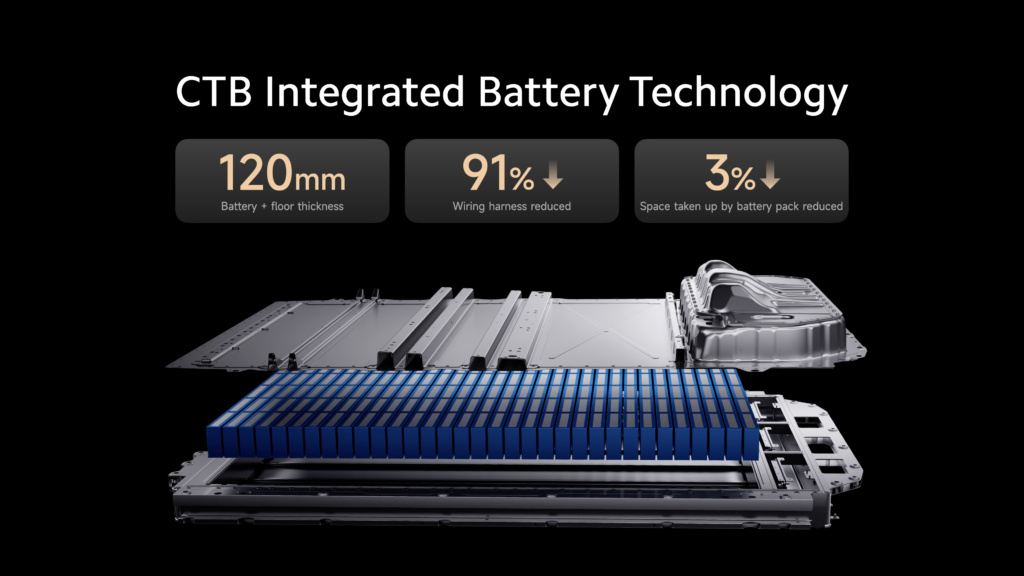
Xiaomi has created its battery tech called CTB Integrated Battery Technology. It’s super efficient, with a 77.8% integration rate, making it the best in the world. Plus, it’s improved performance by 24.4% and reduced height by 17mm.
These batteries can hold up to 150 kWh of power and can go over 1200 km on a single charge. Safety is a top priority for Xiaomi, especially during long trips. They’ve built their batteries with special features like a pressure relief valve that releases energy quickly in emergencies.
They also have a 14-layer protection system to keep everything safe from all angles. To keep the batteries cool, Xiaomi uses a dual-side water cooling system. It’s way bigger than what most other companies use, covering 7.8m² of cooling area.
They’ve even added aerogel insulation material to withstand extreme temperatures up to 1000°C. Xiaomi’s Electric Vehicles (EVs) come with their own Battery Management System (BMS) that’s super safe, and rated ASIL-D—the highest safety level.
It has three thermal monitors and alarms to detect any issues early on. Xiaomi Electric Car SU7 batteries go through rigorous testing to make sure they’re reliable and meet international safety standards.
Read Canoo Pickup Truck (Expected 2024)
Innovative Die-Casting Technology
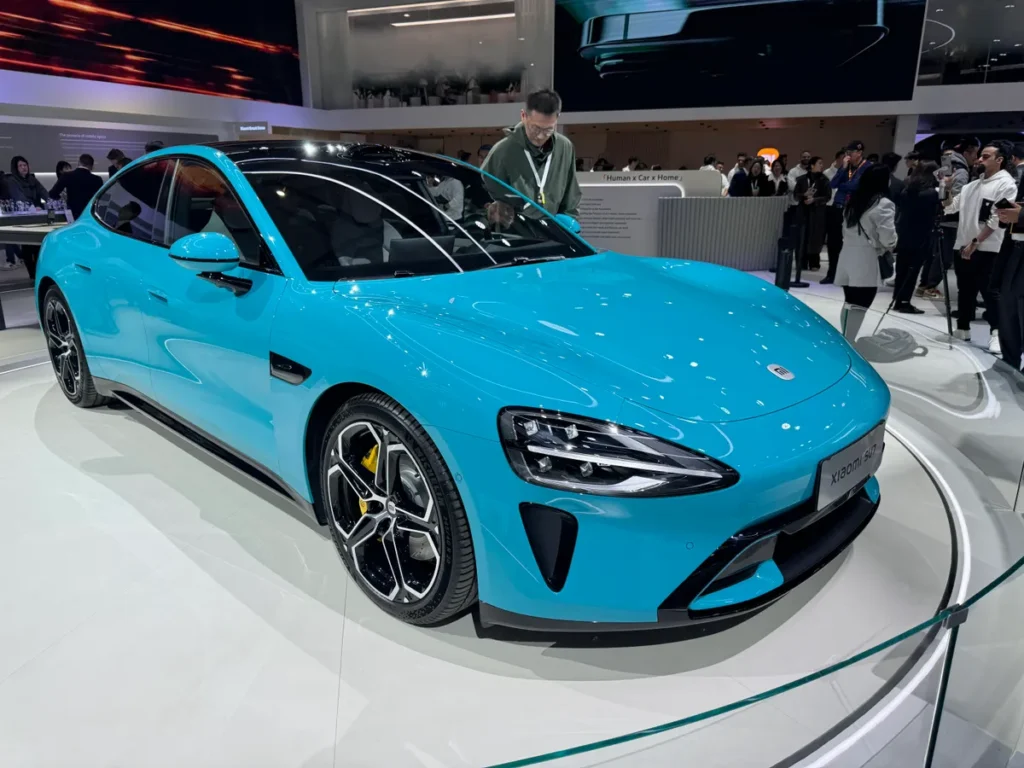
Xiaomi has introduced its die-casting technology called Xiaomi Hyper Die-Casting T9100 and a special alloy material called Xiaomi Titans Metal. They’re the only carmaker in the country researching both big die-casting machines and materials.
The Xiaomi Hyper Die-Casting T9100 is huge, covering an area of 840m² and weighing 1050t. It’s super strong, with a locking force of 9100t. Xiaomi has developed a smart system that checks each piece in just 2 seconds, making it ten times faster than manual checks.
Using this technology, Xiaomi EVs can combine 72 components into one, reducing weight by 17% and cutting production time by 45%. In material research, Xiaomi created Xiaomi Titans Metal—a tough material that can withstand heat and pressure.
They used a special system to find the best alloy formula out of over 10 million possibilities, ensuring it’s strong and stable. While others focus on how much pressure their die-casting machines can handle, Xiaomi is focused on researching everything from materials to equipment.
They’ve covered almost every step in the die-casting process, aiming for top-notch quality and efficiency.
Read Can Aptera Car Dethrone Tesla?
Xiaomi’s Smart Driving Technology
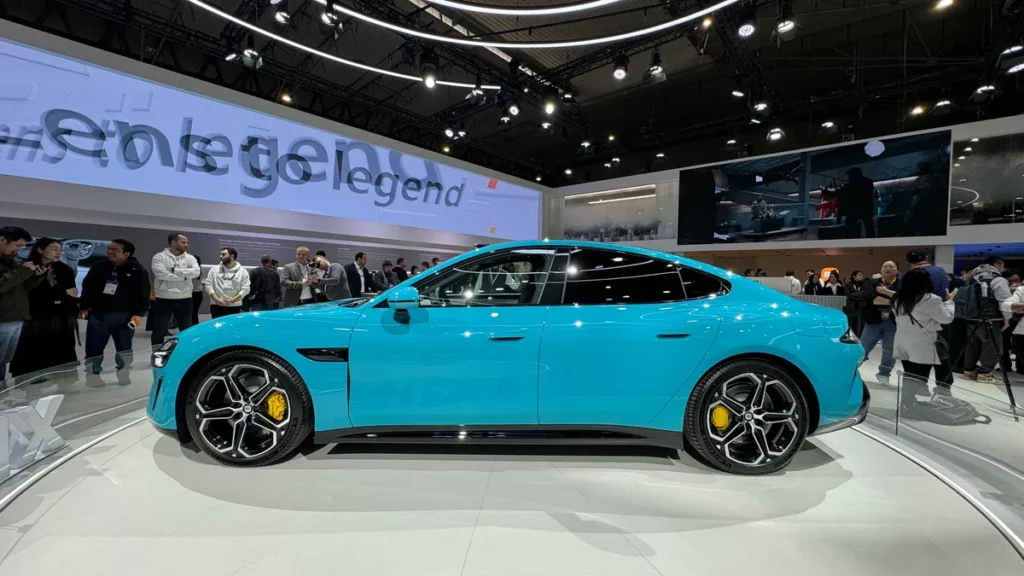
In the world of smart software, Xiaomi stands out as a leader, bridging the gap between cars and electronics with intelligent systems.
Their autonomous driving technology, known as Xiaomi Pilot Autonomous Driving, introduces three key innovations: Adaptive BEV Technology, Road-Mapping Foundational Model, and Super-Res Occupancy Network Technology.
Adaptive BEV Technology is a game-changer, using different perception algorithms depending on the driving scenario. It provides precise awareness, with a recognition range from 5cm to 250m, ensuring clear vision in urban areas, on highways, and even in parking lots.
The Road-Mapping Foundational Model rethinks how cars understand the road. It learns from real-time situations and driver habits to navigate complex intersections without relying solely on high-definition maps.
Xiaomi’s Super-Res Occupancy Network Technology takes obstacle recognition to the next level. Instead of seeing obstacles as blocks, it visualizes them as continuous curved surfaces, boosting accuracy to an impressive 0.1m.
Plus, their noise reduction feature cuts through rain and snow, reducing the chance of mistakes. In addition to these innovations, Xiaomi has developed the world’s first “End-to-End Sensing and Decision-Making AI Model” for automated parking.
This model adapts in real-time, making parking in tricky situations, like garages with elevators, a breeze. On the hardware side, Xiaomi’s SU7 system is powered by top-of-the-line components, including two NVIDIA Orin chips and advanced perception hardware like LiDAR and high-definition cameras.
With their cutting-edge technology and in-depth research, Xiaomi’s autonomous driving system is on track to be among the best in the industry by 2024.
Read Top 10 Electric Cars with Longest Range
Xiaomi Electric Car SU7 Interior

The cabin of the Xiaomi Electric Car SU7 is designed with people in mind, featuring a user-friendly setup. It includes a 16.1-inch 3K central console, a 56-inch HUD head-up display, a 7.1-inch rotating dashboard, and two mounts on the back of the seats for tablets.
It runs on the Snapdragon 8295 in-car chip, with AI power of up to 30 TOPS, connecting five screens for an immersive experience. Using Xiaomi’s SU7 Smart Cabin feels like using a tablet, making it easy for users to adapt without a learning curve.
The system is super smooth, with the car’s operating system launching in just 1.49 seconds after unlocking the door. It seamlessly connects with smartphones, displaying an icon on the console when a phone is brought in, giving easy access to its interface with a single touch.
The in-car operating system integrates mainstream apps, including Xiaomi’s tablet app ecosystem, and gradually adapts to over 5000 apps. Smartphone apps can be pinned to the car console, turning them into in-car apps instantly.
Xiaomi Electric Car SU7 supports over 1000 smart home devices, seamlessly integrating them with the car for automation scenarios, creating a robust CarIoT ecosystem. The car interior has dedicated connections for various devices, supporting plug-and-play functionality.
Xiaomi Electric Car SU7 fully supports CarPlay, iPad mounting, and applications on the rear extension mount, meeting the needs of users.
Read BYD’s New $10k EV Will Destroy EV Companies?
Buy On Amazon
Read Amazon Rivian: Amazon Electric Van
The Future of Electric Mobility?
Only time will tell if the Xiaomi Electric Car SU7 lives up to the hype. However, its arrival signifies a growing trend of tech giants entering the electric car market.
This competition can only benefit consumers by driving down prices, increasing innovation, and offering a wider range of electric car options.
With its competitive pricing and feature set, the Xiaomi Electric Car SU7 is certainly a car to watch as it seeks to carve out a niche in the ever-evolving electric car landscape.
FAQs
1. What is the range of the Xiaomi Electric Car SU7?
Boasting a range between 700-900 km on a single charge and undercutting popular EVs like Tesla and BYD in price has resulted in long queues of buyers for Xiaomi Electric Car SU7.
2. How much is Xiaomi EV?
$29,900
Xiaomi Electric Car SU7 enters a crowded China EV market with an attention-grabbing price tag – under $30,000 for the base model, cheaper than Tesla’s (TSLA.O), and opens a new tab Model 3 in China.
3. Whose brand is Xiaomi?
Xiaomi Corporation (/ˈʃaʊmi/; Chinese: 小米), commonly known as Xiaomi and registered as Xiaomi Inc., is a Chinese designer and manufacturer of consumer electronics and related software, home appliances, automobiles and household hardware.
4. Who is the current owner of Xiaomi?
Xiaomi – Founders/Owners. Lei Jun is the founder, CEO, and President of Xiaomi. The other co-founders are Lin Bin, Dr. Zhou Guangping, Liu De, Li Wanqiang, Wong Kong-Kat, Hong Feng and Chuan Wang.
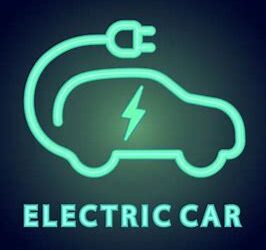
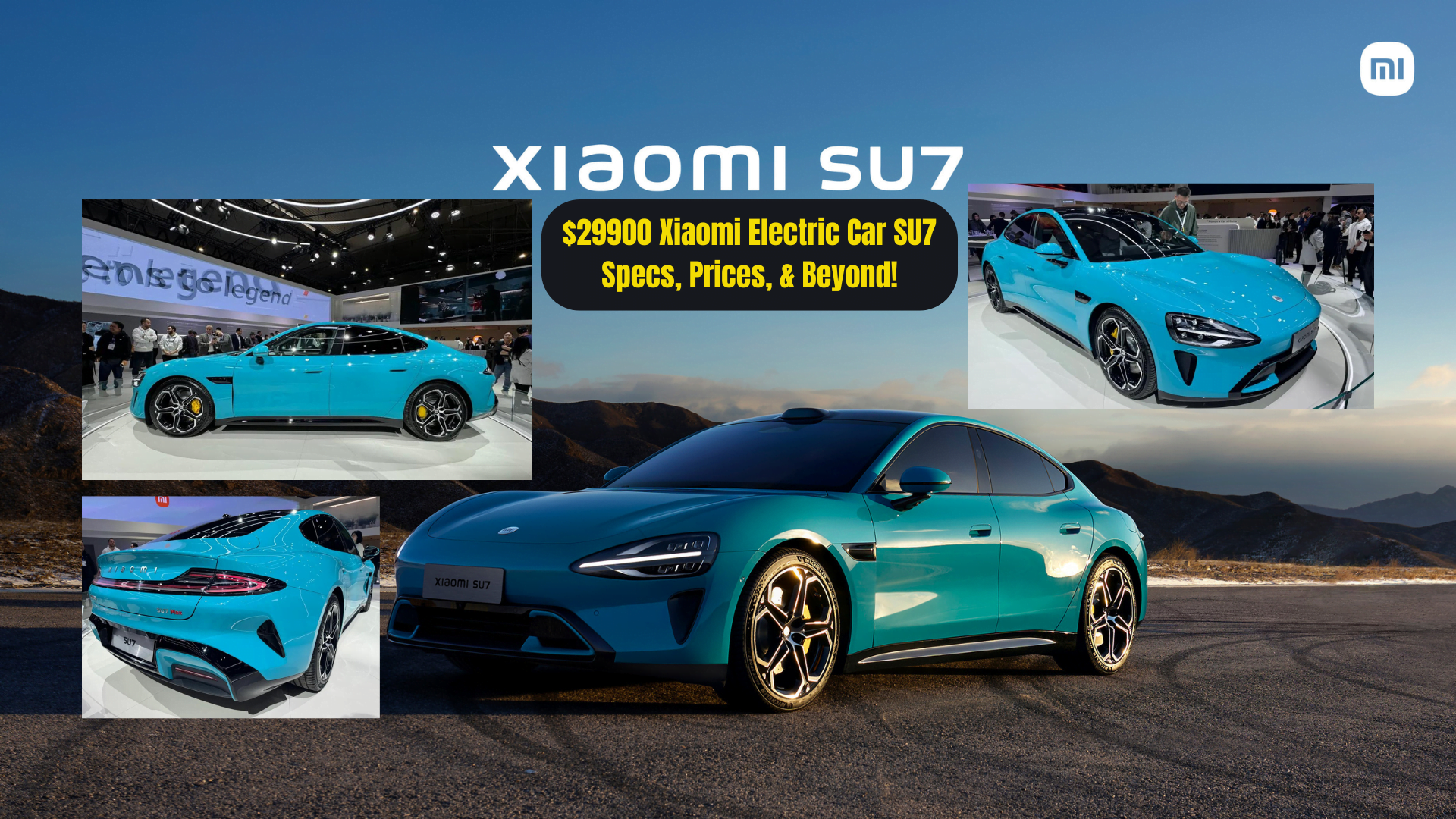



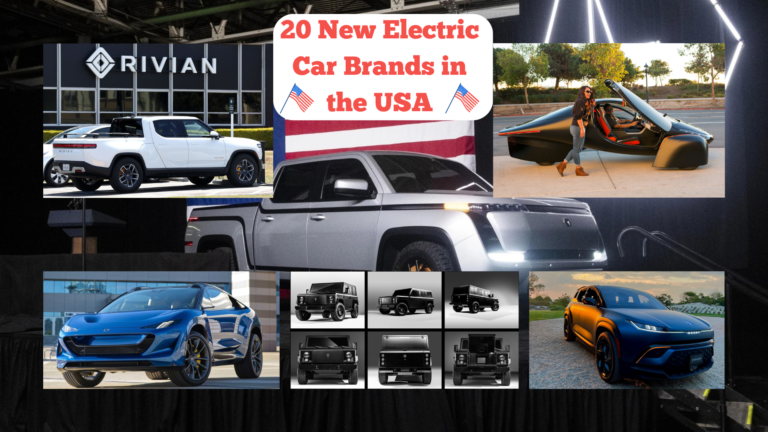
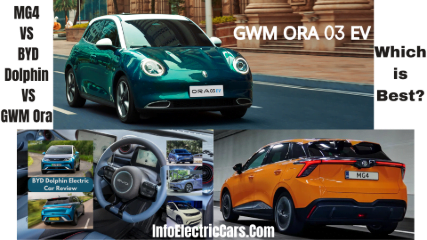
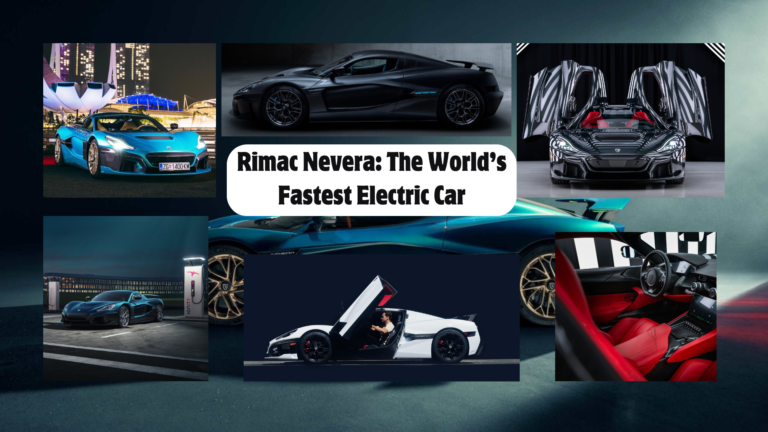

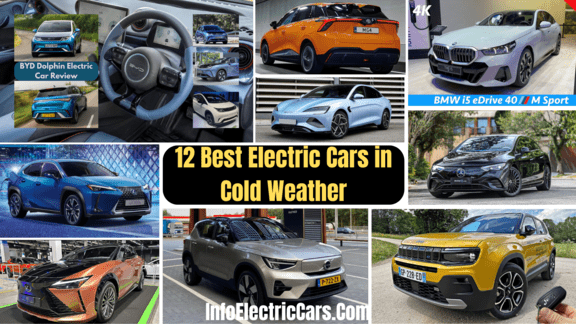
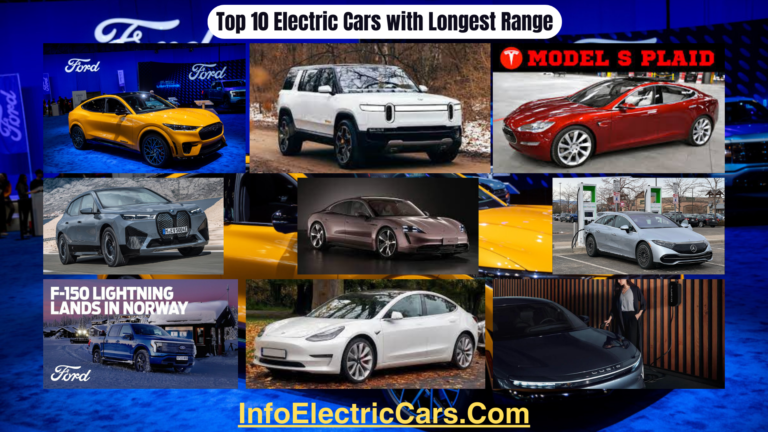
One Comment